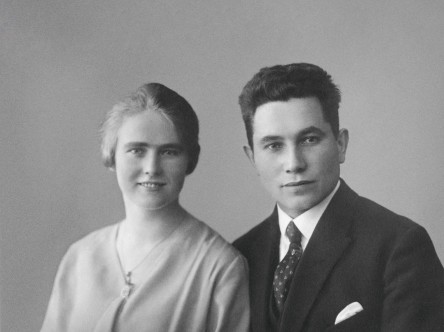Ustanovitev
Aprila 1925 sta Albert Fezer in Gottlieb Stoll ustanovila podjetje "Fezer & Stoll", ki se je ukvarjalo s proizvodnjo strojev za obdelavo lesa. Že naslednje leto sta prijavila prvi patent za vsestranski univerzalni mizarski stroj (ZUM). Blagovna znamka Festo, ki je bila prvič uporabljena pri stroju ZUM za prodajo izdelkov, izhaja iz priimkov obeh ustanoviteljev in je od takrat sinonim za inovacije. Po nekaj letih Albert Fezer zapusti podjetje in Gottlieb Stoll prevzame izključno odgovornost.
Ob podpori žene Berte mu podjetje uspe razvijati in širiti. Od samega začetka je v podjetju uveljavljal načela racionalizacije, da bi optimiziral delovne procese tako v svojem podjetju kot pri strankah.
Prvi sedež podjetja na Ulmer Straße v kraju Esslingen am Neckar je bil zgrajen leta 1939. Tako so zdaj vsa poslovna področja združena pod eno streho. Tu nastajajo sodobni proizvodni in pisarniški prostori, opremljeni z najnaprednejšimi proizvodnimi stroji in tehnologijami.

"Festo je delo mnogih rok."
Gottlieb Stoll z ženo Berto
Pnevmatika in internacionalizacija
Leta 1950 se Kurt Stoll, najstarejši sin Gottlieba in Berte Stoll, na sejmu v Chicagu seznani s pnevmatiko in spozna njen potencial za avtomatizacijo. Pnevmatiko pripelje v Nemčijo in jo še naprej razvija v očetovem podjetju. Sredi petdesetih let prejšnjega stoletja je ustanovljen oddelek Festo Pneumatics in podjetje začne proizvajati pnevmatske cilindre.
Festo raste in prehaja na mednarodno raven: leta 1956 je v Italiji ustanovljena prva nacionalna podružnica, ki ji sledijo ustanovitve v Švici, Franciji in Avstriji. Medtem ko Kurt Stoll vodi področje Festo Pneumatics, njegov brat Wilfried Stoll postane prvi izvršni direktor družbe Festo Österreich. Spodbuja mednarodno pozicioniranje in ustanavljanje novih podjetij Festo za krepitev blagovne znamke.
Podjetje je v šestdesetih letih prejšnjega stoletja skupaj s Festo Didactic razvijalo programe usposabljanja za pripravnike, zaposlene in stranke. Tako je postala nova tehnologija dostopna našim strankam. Leta 1965 je objavljen prvi učbenik in ustanovljen je oddelek Festo Didactic.
Leta 1962 je v Berkheimu ustanovljena prva lastna lokacija za področje Festo Pneumatics. Tu sta uprava in proizvodnja centralizirani na enem mestu. Kmalu zatem, leta 1968, Festo odpre proizvodni obrat v Rohrbachu.
Kurt je leta 1959 dokončal inženirski študij na Tehnični univerzi v Stuttgartu, kjer je z diplomsko nalogo o tehnologiji pnevmatskega krmiljenja postavil nove standarde. Leta 1992 je prejel častni doktorat Tehnične univerze na Dunaju.
Medtem ko se Kurt odloči za tehnično kariero, se Wilfried odloči za poslovno pot. Leta 1962 je na Univerzi za mednarodno trgovino na Dunaju diplomiral iz poslovne administracije, leta 1969 pa je na dunajski Univerzi za ekonomijo in poslovno administracijo doktoriral z disertacijo o celovitem načrtovanju podjetij.
Brata sta bila desetletja dejavna v upravi in pozneje v nadzornem svetu družbe Festo. Za svoje dosežke in predanost gospodarstvu sta prejela številna priznanja, med drugim poslovno medaljo Baden-Württemberg 2023.
Kompleksnost in priložnosti
V sedemdesetih letih 20. stoletja sta brata Kurt in Wilfried Stoll podjetje reorganizirala na tržno usmerjen način. Poleg posodabljanja organizacijske strukture se dodatno razvija tudi tehnična infrastruktura. Z uvedbo elektronske obdelave podatkov (EDP) so različna področja, oddelki in družbe Festo povezani v mrežo, kar vodi k optimizaciji procesov, hitrejši proizvodnji in krajšim dobavnim rokom.
Prvi sistem za elektronsko obdelavo podatkov je bil v Berkheimu nameščen že leta 1968. Poleg tega se logistični center v Berkheimu spreminja v sodoben distribucijski center z avtomatiziranim visokoregalnim skladiščem in podatkovnim centrom.
Festo širi svoj portfelj izdelkov, da bi izpolnil vse večje in kompleksnejše zahteve svojih strank. V podjetju so ustanovljene nove poslovne enote, kot so Festo Electronic, Festo Sensoric in Festo Cybernetic.
Učeča se organizacija
Družba je začela novo pot: Festo leta 1997 postane delniška družba, predsednik uprave je Wilfried Stoll, predsednik nadzornega sveta pa Kurt Stoll. Leta 2000 se družbi Festo in Festool razdelita v dve podjetji.
V devetdesetih letih se podjetje reorganizira: Festo se obravnava kot učeča se organizacija. Uvedena je nova korporativna grafična podoba. Na spletu je dostopna prva domača stran. Kupci imajo zdaj možnost kupiti izdelke Festo tudi v spletni trgovini. Po vsem svetu nastajajo nove lokacije za proizvodnjo, logistiko in tehnični razvoj. Družba Festo je prvi ventilski otok na trgu predstavila leta 1989 in od takrat razvija modele za različna področja uporabe.
Tudi področje Didactic izvaja nove projekte, v Rohrbachu pa se v sodelovanju z deželo Posarje odpira učni center Festo Saar. Didactic zdaj prodaja tudi celotne učne tovarne v sektorju tehničnega izobraževanja.
Festo se iz narave uči že od začetka devetdesetih let prejšnjega stoletja: leta 2006 je bila ustanovljena mreža Bionic Learning Network, ki družbo Festo povezuje z univerzami, inštituti in razvojnimi podjetji. Leta 2010 je bionični pomočnik za rokovanje družbe Festo prejel nemško nagrado prihodnosti.
V prihodnost
Festo se osredotoča na inovacije in napredek, da bi se proaktivno spopadel z izzivi prihodnosti. V ta namen podjetje nenehno širi svoje temeljne kompetence in vključuje nova področja, kot so električna avtomatizacija, avtomatizacija procesov in SupraMotion. Cilj te strateške diverzifikacije je ustvariti nove priložnosti in
bolje integrirati tehnologije za poenostavitev dela naših strank. Poleg uvajanja novih poslovnih področij Festo v svoje izdelke vključuje tudi sodobne tehnologije. Med njimi so piezo tehnologija, umetna inteligenca, pametne tovarne in tehnologije interneta stvari.
V kontekstu globalnih sprememb Festo vidi biogospodarstvo kot v prihodnost usmerjen koncept, ki spodbuja harmoničen odnos med ljudmi in naravo.
Leta 2015 je bil sedežu dodan 16-nadstropni center za avtomatizacijo, ki je prva stolpnica družbe Festo. V novoodprtih centrih Festo Experience Center lahko naše stranke dobijo navdih za inovativne tehnologije.